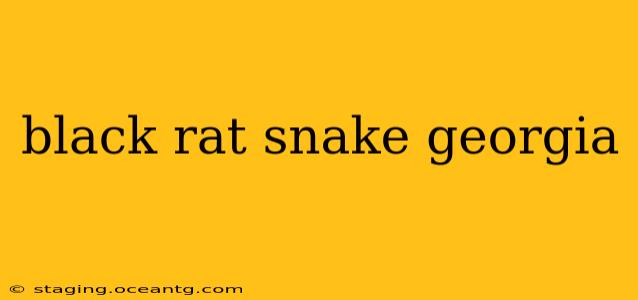Georgia is home to a fascinating array of wildlife, and among its slithering inhabitants is the black rat snake ( Pantherophis obsoletus). Often mistaken for other species, understanding its characteristics, habitat, and role in the ecosystem is crucial for appreciating this beneficial reptile. This comprehensive guide will delve into everything you need to know about the black rat snake in Georgia.
What are the distinguishing features of a black rat snake in Georgia?
Identifying a black rat snake can be tricky, as its appearance varies. While the name suggests a uniformly black coloration, Georgia's black rat snakes can exhibit a range of colors from jet black to dark gray or even a brownish-black. Juveniles often display a pattern of blotches or saddles, which fade as they mature. Key identifying features include their smooth scales, large size (they can reach up to 6 feet in length!), and a relatively slender body. Their eyes are typically round and black. Unlike venomous snakes, they possess round pupils. Confusing them with venomous cottonmouths or copperheads is a common mistake; however, careful observation of these features can help distinguish them.
Where do black rat snakes live in Georgia?
Black rat snakes are highly adaptable and can be found across a wide range of habitats in Georgia. They prefer areas with access to cover, such as forests, fields, swamps, and even urban areas. They are often found near water sources and are excellent climbers, frequently utilizing trees and other structures for shelter and hunting. You're likely to encounter them in wooded areas near streams, in rock piles, or even in attics and sheds.
Are black rat snakes dangerous to humans?
No, black rat snakes are not venomous and pose no significant threat to humans. While they can deliver a painful bite if handled carelessly, they are not aggressive and will typically try to escape confrontation. Their bite is primarily defensive and rarely causes serious injury. They are considered beneficial to humans due to their role in controlling rodent populations.
What do black rat snakes eat?
Black rat snakes are primarily constrictors, meaning they subdue their prey by wrapping their bodies around them and squeezing until they suffocate. Their diet consists mainly of rodents, such as rats and mice, making them valuable in pest control. They may also consume birds, eggs, and occasionally other small animals. Their ability to effectively control rodent populations makes them beneficial to agricultural settings and even human residences.
How can I tell the difference between a black rat snake and a black racer?
This is a frequently asked question! Both are all-black snakes, often leading to confusion. The key difference lies in their head shape and behavior. Black racers tend to have a more pointed head, and they are known for their speed and aggressive demeanor—they'll often flee quickly when disturbed. Black rat snakes possess a slightly blunter head, and though they can move quickly, they are generally less inclined to flee immediately. Their behavior is usually more defensive.
Are black rat snakes protected in Georgia?
While black rat snakes are not currently listed as a protected species in Georgia, their populations are vulnerable to habitat loss and human persecution. It is important to remember that these animals play a valuable role in the ecosystem and should be treated with respect. They should not be harmed unless they pose a direct threat.
What should I do if I encounter a black rat snake?
If you encounter a black rat snake, the best course of action is to give it space. Admire it from a safe distance, and allow it to move away on its own. Never attempt to handle it unless you are a trained professional. If it is in an undesirable location such as your home, contact a wildlife removal specialist for assistance.
This guide provides a thorough overview of black rat snakes in Georgia, addressing common questions and concerns. Remember, appreciating and understanding Georgia's diverse wildlife is crucial for ensuring their continued well-being and our own safety.
